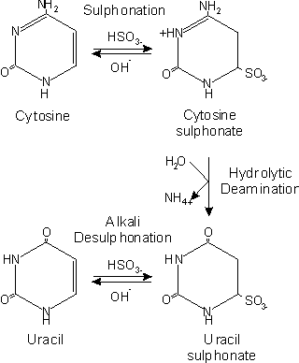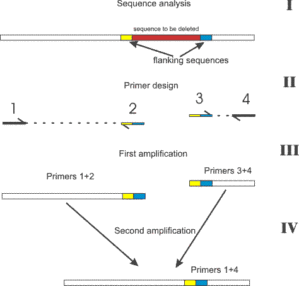第三章 大肠杆菌感受态细胞的制备和转化第一节 概 述 在自然条件下很多质粒都可通过细菌接合作用转移到新的宿主内但在人工构建的质粒载体中一般缺乏此种转移所必需的mob基因因此不能自行完成从一个细胞到另一个细胞的接合转移。如需将质粒载体转移进受体细菌,需诱导受体细菌产生一种短暂的感受态以摄取外源DNA。 转化(Transformation)是将外源DNA分子引入受体细胞使之获得新的遗传性状的一种手 ...
第五章 重组质粒的连接、转化及筛选第一节 概 述 质粒具有稳定可靠和操作简便的优点。如果要克隆较小的DNA片段(<10kb)且结构简单质粒要比其它任何载体都要好。在质粒载体上进行克隆从原理上说是很简单的,先用限制性内切酶切割质粒DNA和目的DNA片段 然后体外使两者相连接 再用所得到重组质粒转化细菌即可完成。但在实际工作中 如何区分插入有外源DNA的重组质粒和无插入而自身环化的载体分子是较为困难 ...
第六章 基因组DNA的提取第一节 概 述 基因组DNA的提取通常用于构建基因组文库、Southern杂交(包括RFLP)及PCR分离基因等。利用基因组DNA较长的特性可以将其与细胞器或质粒等小分子DNA分离。加入一定量的异丙醇或乙醇,基因组的大分子DNA即沉淀形成纤维状絮团飘浮其中 可用玻棒将其取出,而小分子DNA则只形成颗粒状沉淀附于壁上及底部 从而达到提取的目的。在提取过程中染色体会发生机械 ...
第九章 分子杂交技术 互补的核苷酸序列通过Walson-Crick碱基配对形成稳定的杂合双链分子DNA分子的过程称为杂交。杂交过程是高度特异性的可以根据所使用的探针已知序列进行特异性的靶序列检测。 杂交的双方是所使用探针和要检测的核酸。该检测对象可以是克隆化的基因组DNA也可以是细胞总DNA或总RNA。根据使用的方法被检测的核酸可以是提纯的,也可以在细胞内杂交 即细胞原位杂交。探针必须经过标记 ...
Cool growth competent E . coliThis protocol is very effective and simple. The fact that the cells are grown at low temperature greatly increase the OD range during which the cells will prep up at high ...
Analysis of methylation using bisulphite sequencingContributed by Dr. A. GratchevThis method allows precise analysis of methylation in a certain region by converting all nonmethylated cytosines into t ...
digest genomic phage DNA:EcoRI Digestion10x EcoRI buffer0.5 mlphage DNA (200 ng)4.5 mlEco RI (20 u/ml)0.2 mltotal5.2 mlincubate for 15 min at 37°C (heating block or water bath) heat for 5 min at 65° ...
Desalting Oligonucleotides by Ethanol Precipitation Measure the volume of the oligonucleotide solution to be precipitated. Chill 95% Ethanol in the freezer at -20 °C or on dry ice prior to use. Perfor ...
Desalting Oligonucleotides by Butanol ExtractionDry the oligonucleotide on the speed-vac prior to butanol extraction. Re-suspend the oligonucleotide in 100 m l of water (HPLC grade or better) and tran ...
Colony Cracking: Quick Test for Inserts in PlasmidsE. coli cells can be disrupted in an alkaline solution containing detergent. The lysate contains enough DNA to be detected in a single lane of an aga ...
Protocols for ET recombination.Oligo designThe 5' end (the homology arm) - choose 42 or more (we usually choose about 50) nts for the homology arms from the target DNA sequence simply according to whe ...
Vector systems for cloning different sizes of DNA fragmentsCell-based DNA cloning has been used widely as a tool for producing quantities of pure DNA for physical characterization and functional studi ...
Vector systems for cloning different sizes of DNA fragmentsCell-based DNA cloning has been used widely as a tool for producing quantities of pure DNA for physical characterization and functional studi ...
Subcloning Tips - very important heating stepSource: SchimmelpenninckAbstract: Put your insert and vector in an Eppendorff tube and then heat it for 5 minutes then add ligation buffer and ligaseAfter ...
The following protocol is designed for subcloning inserts (I) from one vector into another vector (V). The inserts can be anywhere from 30 bp to 8 kb (possibly higher).Perform restriction digests of ...
Construction of homemade 'T-vectors'This method is after Marchuk D. et al. 1991 Nucl. Acids Res. 19(5) pp 1154. You will need: 10 x Taq buffer (Promega)Taq Polymerase (Promega)Phenol/chloroform mix100 ...
Analys of Genomic DNA by Southern Hybridization (Southern Blot) Outline:Localization of particular sequences within genomic DNA is usually accomplished by the transfer techniques described by Southern ...
Analysis of Genomic DNA by Southern HybridizationProbe preparationSelect several independent BAC clones containing the same inserts that will be used as a probe. Confirm the BAC clone integrity using ...
Creating a deletion by PCR splicingContributed by Dr.A.GratchevI didn't want to place this in the methods section due to its simplicity. To delete a desired fragment from existing DNA fragment all you ...







